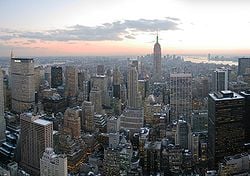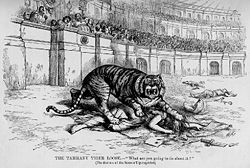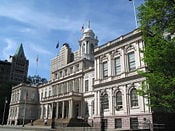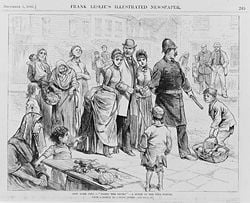Manhattan
| Manhattan | |
| — Borough of New York City — | |
| New York County | |
| Midtown Manhattan as seen from the GE Building. | |
| Coordinates: 40°44′N 73°59′W | |
|---|---|
| Country | United States |
| State | New York |
| County | New York County |
| City | New York City |
| Settled | 1624 |
| Government | |
| - Type | Borough (New York City) |
| - Borough President | Scott Stringer (D) — (Borough of Manhattan) |
| - District Attorney | Cyrus Vance, Jr. — (New York County) |
| Area | |
| - Total | 33.77 sq mi (87.5 km²) |
| - Land | 22.96 sq mi (59.5 km²) |
| - Water | 10.81 sq mi (28 km²) |
| Population (2010) | |
| - Total | 1,585,873 |
| - Density | 70,951/sq mi (27,394.3/km²) |
| - Demonym | Manhattanite |
| Time zone | EST (UTC-5) |
| - Summer (DST) | EDT (UTC-4) |
| Website: Official Website of the Manhattan Borough President | |
Manhattan is a borough of New York City, New York, USA, coterminous with New York County. It is the most densely populated area in the United States. The Island of Manhattan is the largest section of the borough, which also includes several smaller islands and a small section of the mainland adjacent to The Bronx. The name Manhattan derives from the word Manna-hata, as written in the 1609 logbook of Robert Juet, an officer on Henry Hudson's yacht Halve Maen (Half Moon).
A commercial, financial, and cultural center of the city, Manhattan has many famous landmarks, tourist attractions, museums, and universities. It is also home to the headquarters of the United Nations and the seat of city government. Manhattan has the largest central business district in the United States. It is the site of both the New York Stock Exchange and NASDAQ, and is the home to the largest number of corporate headquarters in the nation.
History
Colonial
The area that is now Manhattan was long inhabited by the Lenape tribe. In 1524, Lenape, in canoes, met Giovanni da Verrazzano, the first European explorer to pass New York Harbor. [1] It was not until the voyage of Henry Hudson, an Englishman who worked for the Dutch East India Company, that the area was mapped.[2] Hudson discovered Manhattan Island on September 11, 1609 and continued up the river that bears his name until he arrived at the site of present day Albany.[3]
A permanent European presence in "New Netherland" began in 1624 with the founding of a Dutch fur trading settlement on Governors Island. In 1625, Manhattan Island was chosen as the site of Fort Amsterdam, a citadel for the protection of the new arrivals; establishment is recognized as the birth date of New York City.[4] In 1626, Peter Minuit acquired Manhattan from native people in exchange for trade goods, often said to be worth $24.
In 1647, Peter Stuyvesant was appointed as the last Dutch Director General of the colony.[5] The colony was granted self-government in 1652 and New Amsterdam was formally incorporated as a city on February 2, 1653.[6] In 1664, the British conquered the area and renamed it "New York" after the English Duke of York and Albany. Stuyvesant and his council negotiated 24 articles of provisional transfer with the British which sought to guarantee New Netherlanders liberties, including freedom of religion, under British rule.[7]
American Revolution and early United States
Manhattan was at the heart of the New York Campaign, a series of major battles in the early American Revolutionary War. The Continental Army was forced to abandon Manhattan after the disastrous Battle of Fort Washington on November 16, 1776. The city became the British political and military center of operations in North America for the remainder of the war.[8] Manhattan was greatly damaged by the Great Fire of New York during the British military rule that followed. British occupation lasted until November 25, 1783, when George Washington returned to Manhattan, as the last British forces left the city.
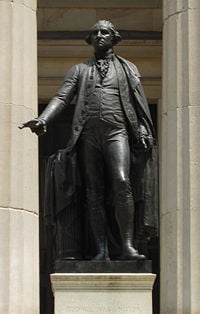
From January 11, 1785 to Autumn 1788, New York City was the fifth of five U.S. capitals under the Articles of Confederation, with the Continental Congress residing at New York City Hall, then at Fraunces Tavern. New York was the first capital under the newly enacted Constitution of the United States, from March 4, 1789 to August 12, 1790 at Federal Hall.[9]
Nineteenth century growth
New York grew as an economic center, first as a result of Alexander Hamilton's policies and practices as the first Secretary of the Treasury and, later, with the opening of the Erie Canal in 1825, which connected New York's Atlantic port to the vast agricultural producers of the mid-western United States and Canada. By 1835, New York City had surpassed Philadelphia as the largest city in the United States.
In politics, Tammany Hall began to grow in influence with the support of many of the immigrant Irish, culminating in the election of the first Tammany mayor, Fernando Wood, in 1854. The Democratic Party political machine dominated local politics for decades. Central Park, which opened to the public in 1858, became the first landscaped park in an American city and the nation's first public park.[10]
During the American Civil War, the city's strong commercial ties to the South, its growing immigrant population, anger about conscription and resentment at those who could afford to pay $300 to avoid service, led to resentment against Lincoln's war policies, culminating in the three-day long New York Draft Riots of July 1863, one of the worst incidents of civil disorder in American history, with an estimated 119 participants and passersby killed.[11]
After the American Civil War, the rate of immigration from Europe grew steeply, and New York became the first stop for millions seeking a new and better life in the United States, a role acknowledged by the dedication of the Statue of Liberty on October 28, 1886, a gift from the people of France. The new European immigration brought further social upheaval. In a city of tenements packed with poorly paid laborers from dozens of nations, the city was a hotbed of socialist revolution, racketeering, and unionization.
In 1874, the western portion of the present Bronx was transferred to New York County, and in 1895, the remainder of the present Bronx County was annexed. The City of Greater New York was formed in 1898, with Manhattan and the Bronx, though still one county, established as two separate boroughs. On January 1, 1914, the New York State Legislature created Bronx County, and New York County was reduced to its present boundaries.[12]
The twentieth century
The construction of the New York City Subway, first opened in 1904, helped bind the new city together. Tragedy struck the city on March 25, 1911, when the Triangle Shirtwaist Factory fire in Greenwich Village took the lives of 146 garment workers, mostly young women, which would eventually lead to great improvements in the city's fire department, building codes, and workplace regulations.[13] Starting in the 1920s, the city saw the influx of African Americans as part of the Great Migration from the U.S. Southern states and the Harlem Renaissance, part of a larger boom time in the Prohibition era that saw dueling skyscrapers rise in the Manhattan skyline. New York City became the most populous city in the world in 1925, overtaking London, which had reigned for a century.[14]
The period between the World Wars saw the election of reformist mayor Fiorello LaGuardia and the fall of Tammany Hall after 80 years of political dominance.[15] As the city's demographics stabilized, labor unionization brought new protections and affluence to the working class. The city's government and infrastructure underwent a dramatic overhaul under LaGuardia. Despite the effects of the Great Depression, the 1930s saw the building of some of the world's tallest skyscrapers, including numerous Art Deco masterpieces, including the New Yorker Hotel that are still part of the city's skyline today. Much of the design of the city, its famous parks, and roadways was due to the genius of controversial power broker and builder Robert Moses.[16]
Returning World War II veterans and immigrants from Europe created a postwar economic boom that led to the development of huge housing developments, targeted at returning veterans, including Peter Cooper Village—Stuyvesant Town, which opened in 1947.[17] In 1951, the United Nations relocated from its first headquarters in Queens to the East Side of Manhattan.
Like many major U.S. cities, New York suffered race riots and population and industrial decline in the 1960s. By the 1970s, the city had gained a reputation as a graffiti-covered, crime-ridden relic of history. In 1975, the city government faced imminent bankruptcy, and its appeals for assistance were initially rejected, summarized by the classic October 30, 1975 New York Daily News headline as "Ford to City: Drop Dead".[18] This fate was avoided through a federal loan and debt restructuring, and the city was forced to accept increased financial scrutiny by New York State. The 1980s saw a rebirth of Wall Street, and the city reclaimed its role at the center of the world-wide financial industry.
The 1980s also saw Manhattan at the heart of the AIDS crisis, with Greenwich Village at its epicenter. Gay Men's Health Crisis (GMHC) and AIDS Coalition to Unleash Power (ACT UP) were founded to advocate on behalf of those stricken with the disease. Starting in the 1990s, crime rates dropped drastically, and the outflow of population turned around as the city once again became the destination not only of immigrants from around the world but of many U.S. citizens seeking to live a cosmopolitan lifestyle that New York City can offer.
Government
Since New York City's consolidation in 1898, Manhattan has been governed by the New York City Charter, which has provided for a "strong" mayor-council system since its revision in 1989. [19] The centralized New York City government is responsible for public education, correctional institutions, libraries, public safety, recreational facilities, sanitation, water supply, and welfare services in Manhattan.
The office of Borough President was created in the consolidation of 1898 to balance centralization with local authority. Each borough president had a powerful administrative role derived from having a vote on the New York City Board of Estimate, which was responsible for creating and approving the city's budget and proposals for land use. In 1989, the Supreme Court of the United States declared the Board of Estimate system unconstitutional on the grounds that Brooklyn, the most populous borough, had no greater effective representation on the Board than Staten Island, the least populous borough, a violation of the Fourteenth Amendment's Equal Protection Clause pursuant to the high court's 1964 "one man, one vote" decision.[20]
Since 1990, the largely-powerless Borough President has acted as an advocate for the borough at the mayoral agencies, the New York City Council, the New York state government, and corporations. Manhattan has ten City Council members, the third largest contingent among the five boroughs. It also has 12 administrative districts, each served by a local Community Board. Community Boards are representative bodies that field complaints and serve as advocates for local residents.
As the host of the United Nations, the borough is home to the world's largest international consular corps, comprising 105 consulates, consulates general, and honorary consulates.[21] It is also the home of New York City Hall, the seat of New York City government housing the Mayor of New York City and the New York City Council. The mayor's staff and 13 municipal agencies are located in the nearby Manhattan Municipal Building, completed in 1916, which was then known as one of the largest governmental buildings in the world.[22]
Crime
Starting in the mid-nineteenth century, the United States became a magnet for immigrants seeking to escape poverty in their home countries. After arriving in New York, many new arrivals ended up living in squalor in the slums of the Five Points neighborhood, an area between Broadway and the Bowery, northeast of New York City Hall. By the 1820s, the area was home to many gambling dens and brothels and was known as a dangerous place to go to. The area was so notorious at the time that it even caught the attention of Abraham Lincoln, who visited the area before his Cooper Union Address in 1860.[23] The predominantly Irish Five Points Gang was one of the country's first major organized crime entities.
As Italian immigration grew in the early 1900s, many joined the Irish gangs. Gangster Al Capone got his start in crime with the Five Points Gang, [24] as did Lucky Luciano. The Mafia (also known as Cosa Nostra) first developed in the mid-nineteenth century in Sicily and spread to the East Coast of the United States, following waves of Sicilian and Southern Italian emigration. Lucky Luciano established La Cosa Nostra in Manhattan, forming alliances with other criminal enterprises, including the Jewish mob, led by Meyer Lansky, the leading Jewish gangster of that period.[25] From 1920–1933, Prohibition helped create a thriving black market in liquor, which the Mafia was quick to exploit.
New York City experienced a sharp increase in crime during the 1960s and 1970s, with a near fivefold jump in the violent crime rate, from 21.09 per thousand in 1960 to a peak of 102.66 in 1981. Homicides continued to increase in the city as a whole for another decade, with murders recorded by the New York City Police Department, jumping from 390 in 1960 to 1,117 in 1970, 1,812 in 1980, and reaching its peak of 2,262 in 1990. Starting about 1990, New York City saw record declines in homicide, rape, robbery, aggravated assault, violent crime, burglary, larceny, motor vehicle theft and property crime, a trend that has continued, as funds were invested in improved housing and living conditions in the poorest neighborhoods.
Economy
Manhattan is the economic engine of New York City, with its 2.3 million workers drawn from the entire New York metropolitan area, accounting for almost ⅔ of all jobs in New York City. Its most important economic sector is the finance industry, whose 280,000 workers earned more than half of all the wages paid in the borough. Wall Street is frequently used to represent the entire financial industry. New York City is home to the most corporate headquarters of any city in the nation, the overwhelming majority based in Manhattan. Midtown Manhattan is the largest central business district in the United States.[26] Lower Manhattan is home to both the New York Stock Exchange and NASDAQ and is the nation's third-largest central business district (after Chicago's Loop).[27]
Seven of the world's top eight global advertising agency networks are headquartered in Manhattan. The term "Madison Avenue" is often used to refer to the entire advertising field, after Sixth Avenue, renamed "Madison Avenue", became identified with the lucrative advertising industry after the explosive growth in the area in the 1920s. Historically, this corporate presence has been complemented by many independent retailers, though a recent influx of national chain stores has caused many to lament the creeping homogenization of Manhattan.
Housing
In the early days of Manhattan, wood construction and poor access to water supplies left the city vulnerable to fires. In 1776, shortly after the Continental Army evacuated Manhattan and left it to the British, a massive fire broke out, destroying one-third of the city and some 500 houses.[28]
The rise of immigration near the turn of the century left major portions of Manhattan, especially the Lower East Side, densely packed with recent arrivals, crammed into unhealthy and unsanitary housing. Tenements were usually five-stories high, constructed on the then-typical 25x100 lots, with landlords exploiting the new immigrants.[29] By 1929, stricter fire codes and the increased use of elevators in residential buildings were the impetus behind a new housing code that effectively ended the tenement as a form of new construction, though many tenement buildings survive today on the East Side of the borough.
Today, Manhattan offers a wide array of public and private housing options. There were 798,144 housing units in Manhattan as of the 2000 Census, at an average density of 34,756.7/mi² (13,421.8/km²). Only 20.3 percent of Manhattan residents lived in owner-occupied housing, the second-lowest rate of all counties in the nation, behind The Bronx.
Notes
- ↑ Dr. James Sullivan, "The History of New York State: Book I, Chapter III", www.USGenNet.org. "There is satisfactory evidence that Giovanni da Verrazzano sailed into the outer harbor of New York in 1524.
- ↑ Rebecca B. Rankin, and Cleveland Rodgers. New York: the World's Capital City, Its Development and Contributions to Progress. (Harper, 1948).
- ↑ "Henry Hudson and His Exploration," Scientific American, September 25, 1909. www.ulster.net. Retrieved May 1, 2007.
- ↑ City Seal and Flag. www.nyc.gov. New York City. Retrieved May 13, 2007.
- ↑ Jasmin K. Williams, "New York - The Empire States," The New York Post, November 22, 2006. www.nypost.com. Retrieved May 19, 2007.
- ↑ About the Council, New York City Council. www.nycouncil.info.
- ↑ Tolerance Park Historic New Amsterdam on Governors Island. TolerancePark.org.
- ↑ Fort Washington Park. www.nycgovparks.org. Retrieved May 18, 2007.
- ↑ The Nine Capitals of the United States, United States Senate Historical Office. www.senate.gov. Retrieved June 9, 2005. Based on Robert Fortenbaugh. The Nine Capitals of the United States. (York, PA: Maple Press, 1948).
- ↑ Witold Rybczynski, "Olmsted's Triumph," Smithsonian (magazine), July 2003. Retrieved May 29, 2007.
- ↑ Geoffrey C. Ward, "Gangs of New York," a review of Paradise Alley by Kevin Baker, The New York Times, October 6, 2002. query.nytimes.com.Retrieved May 29, 2007.
- ↑ Gary Hermalyn, and Lloyd Ultan, Bronx History: A General Survey, New York Public Library, www.nypl.org. Retrieved April 26, 2007.
- ↑ Jennifer Rosenberg,. Triangle Shirtwaist Factory Fire, history1900s.about.com. Retrieved May 17, 2007.
- ↑ Chase-Dunn, Christopher and Manning, Susan. "City systems and world-systems: Four millennia of city growth and decline," University of California, Riverside Institute for Research on World-Systems. www.irows.ucr.edu. Retrieved May 17, 2007.
- ↑ Oliver E. Allen. The Tiger – The Rise and Fall of Tammany Hall. (Addison-Wesley Publ. Co., 1993) Decline: Chapter 9. questia.com. Retrieved October 22, 2007.
- ↑ Lee Gjertsen. "Robert Moses The controversial power broker who built New York" [1]. politicians.suite101.com. Retrieved July 9, 2008.
- ↑ "Stuyvesant Town to Get Its First Tenants Today," The New York Times, August 1, 1947, 19.
- ↑ Joshua Zeitz, "New York City on the Brink" in American Heritage'' (magazine), November 26, 2005. www.americanheritage.com. Retrieved May 29, 2007.
- ↑ "Report on Ballot Proposals of the 2003 New York City Charter Revision Commission," Association of the Bar of the City of New York. www.abcny.org. Retrieved May 11, 2007.
- ↑ Cornell Law School Supreme Court Collection: Board of Estimate of City of New York v. Morris, Cornell Law School . www.law.cornell.edu. Retrieved June 12, 2006.
- ↑ Society of Foreign Consuls: About us. www.consulsnewyork.com. Retrieved July 19, 2006.
- ↑ The Municipal Building, New York City. www.nyc.gov. Retrieved April 25, 2007.
- ↑ John Walsh, "The Five Points," Irish Cultural Society of the Garden City Area, September 1994. www.irish-society.org. Retrieved May 16, 2007.
- ↑ Al Capone, Chicago History Museum. www.chicagohs.org.
- ↑ Eric Jaffe, "Talking to the Feds: The chief of the FBI's organized crime unit on the history of La Cosa Nostra," Smithsonian (magazine), April 2007. www.smithsonianmagazine.com. Retrieved May 16, 2007.
- ↑ Patricia Noonan, Testimony on Moynihan Station Draft EIS, Partnership for New York City, testimony dated May 31, 2000. www.nycp.org.
- ↑ Lower Manhattan Recovery Office, Federal Transit Administration . www.fta.dot.gov. Retrieved April 26, 2007.
- ↑ Great Fire of 1776, City University of New York . www.virtualny.cuny.edu. Retrieved April 30, 2007. "Some of Washington's advisers suggested burning New York City so that the British would gain little from its capture. This idea was abandoned, and Washington withdrew his forces from the city on September 12, 1776. Three days later, the British occupied the city, and on September 21, a fire broke out in the Fighting Cocks Tavern. Without the city's firemen present and on duty, the fire quickly spread. A third of the city burnt and 493 houses destroyed."
- ↑ Building the Lower East Side Ghetto. www.upress.umn.edu. Retrieved April 30, 2007.
ReferencesISBN links support NWE through referral fees
- Burrows, Edwin G., and Mike Wallace. Gotham: A History of New York City to 1898 (The History of NYC Series). Oxford University Press, 1998. ISBN 0195116348
- Ellis, Edward Robb. The Epic of New York City: A Narrative History. Reprint. Carroll & Graf, 2005. ISBN 0786714360
- Fortenbaugh, Robert. The Nine Capitals of the United States. York, PA: Maple Press, 1948.
- Jackson, Kenneth T. The Encyclopedia of New York City. Yale University Press, 1995. ISBN 0300055366
- Hamill, Pete. Downtown: My Manhattan. New York: Little, Brown, 2004. ISBN 9780316734516
- Shorto, Russell. The Island at the Center of the World: The Epic Story of Dutch Manhattan and the Forgotten Colony That Shaped America. New York: Doubleday, 2004. ISBN 9780385503495
- Mackay, Donald A. The Building of Manhattan. New York: Harper & Row, 1987. ISBN 9780060157883
- Sullivan, Dr. James. The History of New York State. Lewis Historical Publishing Company, Inc., 1927.
External links
All links retrieved April 29, 2025.
- Manhattan District Attorney official site. www.manhattanda.org.
- Aerial view of all bridges in Manhattan. newyorkbirds.free.fr.
- Maps of Building Heights, and Land Value, plus theoretical and zoning-based maps of underdevelopment, all from www.radicalcartography.net.
Credits
New World Encyclopedia writers and editors rewrote and completed the Wikipedia article in accordance with New World Encyclopedia standards. This article abides by terms of the Creative Commons CC-by-sa 3.0 License (CC-by-sa), which may be used and disseminated with proper attribution. Credit is due under the terms of this license that can reference both the New World Encyclopedia contributors and the selfless volunteer contributors of the Wikimedia Foundation. To cite this article click here for a list of acceptable citing formats.The history of earlier contributions by wikipedians is accessible to researchers here:
The history of this article since it was imported to New World Encyclopedia:
Note: Some restrictions may apply to use of individual images which are separately licensed.
